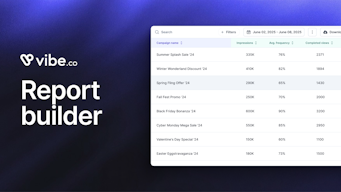CTV Statistics: Market Size, Trends, and Insights
Connected Television is everywhere lately and often described with such superlative language it’s sometimes hard to to believe it’s real. So how large is the CTV market in 2022 and how far has the technology come in the last 2 years? Here is a quick look at the state of the CTV landscape and its projected trajectory. Is it really the silver bullet your media strategy needs? Probably. But first things first: what even is CTV?
What is CTV?
You’ve probably heard of CTV and OTT used interchangeably and, for marketing purposes, they basically refer to the same thing, but there are differences between the two.
CTV, or Connected TV, refers to the device through which ad-supported or subscription-based content is streamed via a web-connected device linked to a television, or a television connected directly to the internet. A CTV device could be a console (such as Xbox or Playstation) or a ‘stick’ which plugs into your television (like Chromecast, Roku, Fire TV, Apple TV, etc.)
OTT, on the other hand, stands for Over The Top, and refers to the content itself, delivered “over the top” of regular broadcast or cable television. As long as there’s an internet connection, OTT provides access to content anytime, anywhere, on any device (i.e., smart TVs, mobile phones, tablets, computers, gaming consoles, Chromecast, Amazon Fire Stick, Roku) and on any streaming service or network (like Netflix, Hulu, or Amazon Prime).
You’re probably familiar with these terms because of your personal experience using them at home, which begins to answer our next question: why is it growing so fast?
Why is CTV growing?
Consumer behavior shifts and a pandemic
A steady consumer shift away from broadcast and cable towards ad-supported and subscription-based streaming had already begun when Covid hit in 2020, but the CTV market growth entered super speed as homebound viewers reassessed their entertainment priorities.
On-demand, ad-supported content grew exponentially as consumers dealt with fluctuating incomes and unreliable work schedules. Today, according to a recent survey by eMarketer, over 53% of video viewing on all devices is on CTVs. That means more people are watching streamed content on CTVs than videos on social media and linear TV combined. Woah.
In fact,
- 85% of all US households with a television own at least one Connected TV device
- Vizio reports that nowadays less than one-third of all TV viewing is linear (traditional tv) compared to 60% from just two years ago as viewers migrate to streaming video.
- Several major streaming services saw double-digit growth in viewing time, with Netflix, YouTube and Hulu experiencing increases of 26%, 21%, and 13% year over year, respectively.
This shift to longer format video streaming also served as a reminder to small and medium sized business advertisers that non-skippable ads next to premium content remains one of the most impactful advertising tools out there, and while expensive linear television advertising contracts may have been out of budget for many, CTV campaigns offering agile digital impressions delivered on the big screen with CPMs comparable to Google Ads have radically democratized access to television advertising.
Advertisers in the know are increasingly pivoting to this powerful medium, while a recent Criteo survey found 44% of Americans confirm video streaming has influenced purchasing decisions in the last 12 months.
In classic chicken and the egg fashion, increasing consumer interest in CTV led to premium content suppliers massively increasing their CTV inventory which in turn led to more CTV consumer adoption and on and on. Long story short, CTV content is getting richer and better every day, and shows no sign of stopping. That’s good for consumers but more importantly, good for you as an advertiser.
Stringent privacy regulations
But there’s another reason the CTV market just won’t quit, and it’s way less fun than awesome streaming television programming: ad tech privacy regulations. Let’s take a look at the trop three privacy concerns advertisers need to consider and how these regulations have affected digital advertising so far:
- Apple’s ATT: Apple’s App Tracking Transparency - launched with the iOS 14.5 update - now requires app developers and advertisers to request user opt-in to track their IDFAs (Identifier for Advertisers) across websites and apps. The roll out isn’t complete but so far 96% of iPhone users have opted out of IDFA. That’s basically a death blow to performance marketing and affordable CPMs on Apple device apps (including social media apps). In fact, Meta just announced that due to the impact of Apple’s new privacy policy, it expects to generate $10 billion less in ad sales.
- Google’s 3rd party cookie deprecation: 3rd party cookies are basically tags placed on websites as users navigate the web. It’s how a company like Google can follow users around the internet and deliver ads to a particular user from one website (say, a shoe store site) on a completely different website (say, a grocery store site). It’s what allows brands with little-to-no 1st-party data to find potential customers. When Google announced they were eliminating 3rd party tracking from Chrome browsers in 2020, it sent advertisers into a panic - with good reason. Traditional methods of digital targeting, tracking, measurement, and attribution, are largely going out the window which means advertisers who don’t prepare for the transition are looking at a massive amount of wasted impressions and sky high CPMs (Cost per Thousand Impressions.)
- GDPR: The General Data Protection Regulation is one of the toughest privacy and security laws in the world. Any advertiser working in the European market using personalized ads or direct marketing to promote a business will be affected by regulations that are being stringently enforced for both large conglomerates and sole traders, so be careful. In a nutshell, GDPR guidelines require advertisers to ask users for permission every time they gather any type of information and guess what, users don’t want to grant access to that information for free anymore! I know we’re beginning to sound like a broken record at this point, but those behavior shifts lead to - you guessed it - wasted impressions and high CPMs.
Current State of the CTV Market
Back to the sudden popularity of CTV: it’s not just the number one choice for media consumers, it’s also increasingly a favorite for advertisers dealing with all of the crazy changes we just listed. CTV is a powerful ad platform to reach specific audience segments and show ROI, including cost per acquisition. That’s why IPG Magna forecasts CTV ad spending to exceed $5.4 billion in 2022.
So that’s how things have been going lately: fast and furious into a brand new model of digital advertising as advertisers and technology providers find their way around CTV systems. With premium content, blue-chip advertisers, and consumer support, CTVs future looks strong.
2023 CTV Statistics
But what’s the current state of the market? How mature is it really? Here are some numbers to give you an idea.
- Consumers continue to migrate to CTV platforms: A recent Leichtman Research Group survey found over 80% of TV households have at least one connected TV device (a penetration higher than cable TV), with a mean of 4.1 devices per connected TV household. To no one’s surprise young adults are the heaviest viewers of CTV.
- Premium inventory is increasing: The recent roll-out of new streaming providers (like Disney +, Paramount + or Sling) with award-winning premium content has helped supercharge consumer adoption. This increase in inventory also means advertisers have way more premium content and time slots to choose from, which is a win-win for the whole CTV ecosystem.
- Advertisers recognize the opportunity and are backing it up with significant budget allotments:
- Insider Intelligence reports that “CTV ad spending is riding a wave of consumer adoption and platform launches. By 2025, spending will reach $34.49 billion, more than double the 2021 total of $14.44 billion.”
- The Trade Desk found 70% of advertisers say their top priority for 2022 TV investments is linking video investments to business outcomes. That’s why they’er flocking to CTV.
- 45% of advertisers grew their CTV ad budget in the past year and 91% will either maintain or grow the CTV ad spend in the next year. An overwhelming majority of advertisers (92%) viewed CTV as just as effective if not more so than linear TV.
SMEs need to jump in now
Clearly, the opportunity for impactful, disruptive advertising is there, but small and medium-sized businesses are not jumping at the chance to advertise on CTV like they should. As of 2022, only 18% of SMEs were taking advantage of CTV’s flexibility and performance marketing power, while large corporations are buying up CTV air time at cut throat rates.
Too many marketers still believe only Fortune 500 companies can afford to advertise on television and aren’t capitalizing on the reach, targeting, lower CPMs, and real-time reporting CTV advertising has to offer.


